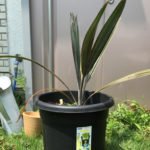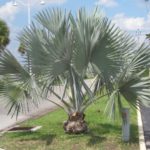ビズマークヤシ Bismarckia Palm
[mmtl-row][mmtl-col width=”1/3″][mmtl-text id=”” class=”” space=”medium”]

Seed 種
[/mmtl-text][/mmtl-col][mmtl-col width=”1/3″][mmtl-text id=”” class=”” space=”medium”]

Seedling 苗
[/mmtl-text][/mmtl-col][mmtl-col width=”1/3″][mmtl-text id=”” class=”” space=”medium”]

Mature Tree 成熟した
[/mmtl-text][/mmtl-col][/mmtl-row][mmtl-row][mmtl-col width=”1/1″][mmtl-text id=”” class=”” space=”medium”]
形態: 直径3mにおよぶ巨大なブルーグレーの扇形の葉を持つ、熱帯地方、亜熱帯地方の華やかなヤシです。高さ約10m程で、どっしりとして表面がなめらかなグレーの幹を持ちます。グリーンの葉のものもあります。雌雄異株のため、雄木と雌木があります。
Description: A spectacular tropical/sub-tropical fan palm with huge blue-grey fan leaves up to 3m (9 feet) across. It has stout, smooth, grey trunk to about 10m (35 feet). There is also a green leaved form. It is dioecious which means that it has male and female plants.
気候と生息環境: マダガスカル原産です。マダガスカルはかなり乾燥して高温気候です。天候が極端で、とても暑く乾燥する一方、雨季には湿気のある状態となる高原や平地で見られます。栽培上の観点からいうと、この種は世界中のもっと熱帯で湿気のある環境でも丈夫に育つことが発見されています。そして、さらに乾燥した砂漠地域でも成功を遂げています。つまり、幅広く多様なコンディションに耐性があるのです。
Climate and Habitat: It is native to Madagascar where it tolerates fairly dry and hot climates. It is seen in plateaus and plain areas where it experiences extremes in weather from very hot and dry to more humid conditions during the rainy season. From a cultural point of view, this species has been found to thrive in more tropical and humid environments around the world but has also had success in drier, desert areas. So, it tolerates a wide variety of conditions.
栽培ポイント: 日当たりが良くて、暖かく、水はけの良い場所が必要です。干ばつに強く耐霜性があります。葉がブルーのものはグリーンのものより一層耐寒性があり、軽度の霜なら生き残ります。大きな扇形の葉を持つヤシとしては適度に早生です。 根の障害に対して過敏なほど敏感なことで有名で、そのため、移植することは大変難しいか不可能です。鉢の植え替え時や、鉢から庭に植え替える時は注意が必要です。確実に根が一本も傷かないことを確認し、根のどの部分も絶対に切り落としてはいけません。
Suggestions for Cultivation: It requires a sunny, warm, and well drained position and is drought, and frost tolerant. The blue form is more cold tolerant than the green form, and can survive light frosts. A reasonably fast grower for a large fan palm. It is notoriously sensitive to root disturbance, and so is very difficult/impossible to transplant, and also need care when potting up or planting out. Make sure none of the roots are broken, and definitely don’t trim any back.
[/mmtl-text][/mmtl-col][/mmtl-row][mmtl-row bg_image=”” bg_repeat=”” bg_position=”” bg_size=”” id=”” class=””][mmtl-col width=”1/3″][mmtl-text id=”” class=”” space=”medium”] Contact: info@shimodapalms.com [/mmtl-text][/mmtl-col][mmtl-col width=”1/3″][mmtl-text][/mmtl-text][mmtl-icon icon=”glyphicons-message-full” id=”” class=”” align=”” space=”medium” size=”medium”][/mmtl-icon][/mmtl-col][mmtl-col width=”1/3″][mmtl-icon icon=”dashicons-palmtree” id=”” class=”” align=”” space=”medium” size=”medium”][/mmtl-icon][/mmtl-col][/mmtl-row]






